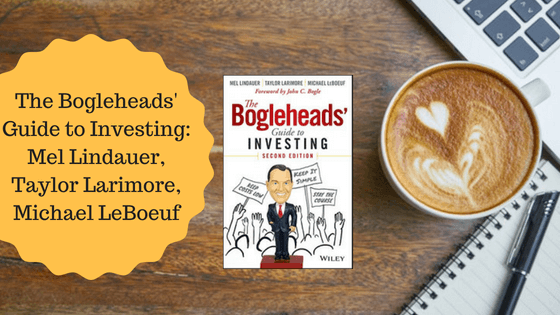
When I started out with becoming the personal finance geek that I am today, being a bibliophile I looked up for personal finance book recommendations. There are a lot of sources recommending varied kinds of books, all geared to either help you think better or streamline your processes when it comes to personal finance. One of my favorite lists that I came across was the 52 books, 52 weeks list on The Simple Dollar. Trent Hamm read 52 personal finance books in the period between November 2006 and November 2007, culminating in weekly book reviews and this extensive list. One of the highly recommended books on the list, which I found common with a lot of other lists was The Bogleheads Guide to Investing.
Who are the Bogleheads?
John C. Bogle, the founder of Vanguard, is well known for his principles of passive investing and the advent of index funds. Bogleheads is the name given to a community of people who believe in and follow the principles laid down by him.
In 1998, the Boglehead journey started from the Vanguard Diehards forum on Morningstar. Very soon, in about 43 months, it became the leading forum with the maximum engagement. Soon, it became an independent forum at diehards.org which morphed into Bogleheads by Feb 2007.
The Bogleheads’ Guide to Investing is a book written by 3 founding Bogleheads (Taylor Larimore, Mel Lindauer and Michael LeBeouf) which details the guiding principles laid down by John Bogle and followed by the community. While it was first published in 2006, the book is packed with valuable information. It is a must-read for anyone wanting an initiation into the process of financial planning and investing.
In the interest of the post length, I will restrict myself to 12 vital learnings I bookmarked from this book.
3 Basic Rules
The book starts with 3 mandates for anyone looking to improve the quality of their life and streamline their finances – 1. Choose the net worth mentality rather than the paycheck mentality 2. Pay off credit card and high-interest debts 3. Establish an emergency fund
While the last 2 points are number-based no-brainers, to me the first point is the real game changer. The day you reject the paycheck to paycheck mentality that you see with most people around you, is the day you become serious about your financial life.
Difference between Speculation and Investing
Bogleheads define a speculator as someone who is expecting to quickly trade and turn in a profit. While some of the speculators may actually profit, the odds are against them. This is not a practice recommended by Bogleheads at all.
They are rather of the view that investing involves holding for long periods and harvesting the returns later on. This is a view I subscribe to, and according to me also a practice that will be less stressful in the longer run.
Passively managed Index Funds are better than Active Investing
Vanguard is a name synonymous with Index Funds. The concept behind it is the numbers to prove that active management has rarely done better than stock Indices like S&P 500. Index funds end up massively reducing the cost of managing the fund, thereby giving better returns than most other actively managed funds.
While this concept is definitely valid for a mature market like the US, in India I do believe actively managed funds are giving incremental returns over market indices, even after taking higher costs into consideration. In fact, there are a few inherent problems with index investing in India, as evidenced by this article.
I also do not agree with the fact that stock picking is not an option. One should not jump into the deep end with no background, education or understanding about value investing. However, when stocks with good fundamentals are held for the long run, in a well-diversified portfolio, I do believe they are more likely to bring higher returns. Get acquainted with the basics of stocks with this post.
Annuities are not a good option
The bogleheads make a case for the fact that with high cost, surrender fees, and decreased tax benefits, annuities are not a good option for investors.
I second that point wholeheartedly. In India too, most annuities ads bring forth such numbers which look attractive but finally the rate of return powering those numbers is pretty bad compared to other investment vehicles.
In the realm of taxation too, annuity holders end up losing out. Annuity income is treated as additional income and taxed at a range of 10-30{76b947d7ef5b3424fa3b69da76ad2c33c34408872c6cc7893e56cc055d3cd886}. Even with the new rule on Long-Term Capital Gains, investors end up paying only 10{76b947d7ef5b3424fa3b69da76ad2c33c34408872c6cc7893e56cc055d3cd886} over Rs. 1,00,000 of gains in equities.
With annuities, in effect, you end up paying post-tax income to get a low rate of return and taxable income.
Asset Allocation

A portfolio with non-correlated volatile assets is more likely to be less volatile and less risky
Henry Markowitz and his portfolio theory are one of the best-known sources of knowledge when it comes to asset allocation. He was one of the first people to point out that a mixture of volatile non-correlated securities could result in a portfolio with lower volatility and possibly higher return. Stocks, bonds, and cash are 3 investment vehicles proven to have worked well together in a portfolio.
The bogleheads recommend you determine your asset allocation on the basis of 4 parameters – goals, time frame, risk tolerance, personal finance situation.
Another recommendation by John Bogle is to own your age in bonds. If like me, you are 30 years old, go ahead and invest 30{76b947d7ef5b3424fa3b69da76ad2c33c34408872c6cc7893e56cc055d3cd886} of your investable money in bonds (*runs away to put in her investment into bonds*).
The reason for this is simple – bonds are a less volatile investment instrument whereby it is advisable to increase contribution to the portfolio, as we age.
Cost should be an important consideration while investing
This fundamental is the backbone of index funds – lower cost, higher returns to the investor.
To be honest, only after reading this did I really start looking up expense ratios for the mutual funds I was considering.
This principle also makes you start questioning if you should buy funds directly from AMCs or from a broker because when you do buy with a broker, you end up paying brokerage and expense ratio on the fund.
The expense ratios for most well-performing mutual funds in India is in the range of 1.70{76b947d7ef5b3424fa3b69da76ad2c33c34408872c6cc7893e56cc055d3cd886}-2.50{76b947d7ef5b3424fa3b69da76ad2c33c34408872c6cc7893e56cc055d3cd886}. You might think that is a miniscule number, but as this example from Value Research shows, Rs. 1 Lakh over 10 years with a return of 15{76b947d7ef5b3424fa3b69da76ad2c33c34408872c6cc7893e56cc055d3cd886} per annum and a 1.5{76b947d7ef5b3424fa3b69da76ad2c33c34408872c6cc7893e56cc055d3cd886} expense ratio grows only to Rs. 3.55 Lakh, instead of the Rs. 4.05 Lakh that it could have grown to – a cumulative difference of 14{76b947d7ef5b3424fa3b69da76ad2c33c34408872c6cc7893e56cc055d3cd886}!
Costs need to be a factor of consideration for stock investing as well. One big reason in favor of long-term investing is the cost you end up paying to the broker when you trade too often, based on the frequency with which you churn.
Churn or turnover is another factor liable to bring down the returns on your mutual fund. Ensure you invest in a fund with a lower turnover ratio.
Performance chasing and market timing are futile
Markets are random, unpredictable and futile. Understand, accept and work around it. Click To TweetTerry Odean and Brad Barber, two professors at the University of California, did a study of 66,400 investors between 1991 and 1997. The study concluded that buy-and-hold investors outperformed most active traders by 7.1{76b947d7ef5b3424fa3b69da76ad2c33c34408872c6cc7893e56cc055d3cd886}!
Invest lesser time, lesser stress and get better returns. I see it as a win-win. So, freeze on a long-term asset allocation and sit tight.
Windfall Management
What’s the first thing that comes to your mind when you think of windfall? Lottery? Improbable?
The authors make some interesting revelations as to how windfall can come through other means like inheritance and divorce settlement and the fact that most people do receive a windfall at least once in their lifetime. Equally revealing is the fact that NBC News reported that more than 70 percent of lottery winners exhaust their fortunes within three years.
To manage a windfall, the authors recommend a 4-step plan – 1. Deposit the money in a safe account for at least six months and leave it alone. 2. Get a realistic estimate of what the windfall can buy. 3. Make a wish list. 4. Get professional help.
If you don’t do anything stupid with the sudden abundance of money, like buying a jet, and let the euphoria pass for the first 6 months, chances are you will make good use of it.
A lot of people forget the taxation aspect and overestimate what this new money can buy them, like the aforesaid jet plane. Ensure sudden new wishes do not exhaust the windfall immediately.
Make a wishlist and chart a realistic path to reach those goals. Take the help of a professional money manager to manage this magnitude of money.
How to choose a Financial Planner
While most Bogleheads are DIY investors, they have some advice for people looking to trust their money to a professional.
First off, you need to be clear about your financial objective and what do you need your money to achieve for you.
Secondly, do your research. Ask around for recommendations and shortlist advisors. Check for their credibility, be it through educational qualification or peer experience. CFP or Certified Financial Planner is a good qualification to look for (Psst! I am one)
Third, check on the cost. Ensure complete transparency in this regard as to who is compensating the advisor and what percentage. The most unbiased advisors work on a fee-only model, whereby the money management fees is a percentage of the assets under management (AUM).
Rebalancing
Rebalancing is the process of reverting to the fixed allocation and sub-allocation in your portfolio. This helps you to sell high and buy low as most stocks revert to mean (RTM).
Rebalancing can be done in 2 ways – frequency based and expansion band based. Frequency-based means an investor rebalances her portfolio at a fixed timeline – quarterly or annually.
Expansion band, on the other hand, means a signal to rebalance once the asset allocation has gone beyond a particular margin. For eg. If the chosen band is 25{76b947d7ef5b3424fa3b69da76ad2c33c34408872c6cc7893e56cc055d3cd886} and the equity allocation for your portfolio is 60{76b947d7ef5b3424fa3b69da76ad2c33c34408872c6cc7893e56cc055d3cd886} – the margin is set at 25{76b947d7ef5b3424fa3b69da76ad2c33c34408872c6cc7893e56cc055d3cd886} of the 60{76b947d7ef5b3424fa3b69da76ad2c33c34408872c6cc7893e56cc055d3cd886}, which would be 15{76b947d7ef5b3424fa3b69da76ad2c33c34408872c6cc7893e56cc055d3cd886}. So, the need for rebalancing arises any time equity goes beyond the range of 45{76b947d7ef5b3424fa3b69da76ad2c33c34408872c6cc7893e56cc055d3cd886} – 75{76b947d7ef5b3424fa3b69da76ad2c33c34408872c6cc7893e56cc055d3cd886}.
Tune out the noise
We all know media works on creating sensationalism. The more you watch and listen to financial media, the more emotional and less rational decisions, you are bound to make.
3 tips by the authors really help in this respect. First, remember all forecasting is noise. Nobody can predict which way the market goes, so don’t waste your time on that.
Second, ignore the hustle. Know that investing is a long drawn-out slow game. For all cricket lovers, it’s a test match and not a T-20. If anyone tells you they can make you rich quick, run Forrest run!
Third, be skeptical and do your own research. Invest some time and if need be in educating yourself. Always do your own research before making any investment decision.
Understand Behavioral Finance
Mastering your emotions will help you to master your investments. We, humans, are an emotional lot and most investment decisions are also guided by those emotions. Fortunately, there’s been some research which shines the light on some of those emotions and it’s repercussions. Educate yourself about it and your rational side could end up winning more often.
Do not expect stock markets to be exciting. For the exciting bit in stock markets where you want to trade more often and chase higher returns, allocate a trading account with 5-10{76b947d7ef5b3424fa3b69da76ad2c33c34408872c6cc7893e56cc055d3cd886} of your portfolio, where the consequences or the possibility of losing it all won’t matter
This is a must-read book for literally anyone looking to get their fundamentals of investing on the correct path.
Have you read the book? Was there one unforgettable lesson that you took away? Let me know in the comments or email me on aparna@elementummoney.com
Read the lessons from more such books:

Get your Personal Finance basics right. Sign up for the Elementum Money 5-day Email course for a crash course on all things Personal Finance, like Money Management,
Insurance, Investments, Loans and Tax Planning.
Also, get notified of all new Elementum Money posts.





Leave a Reply